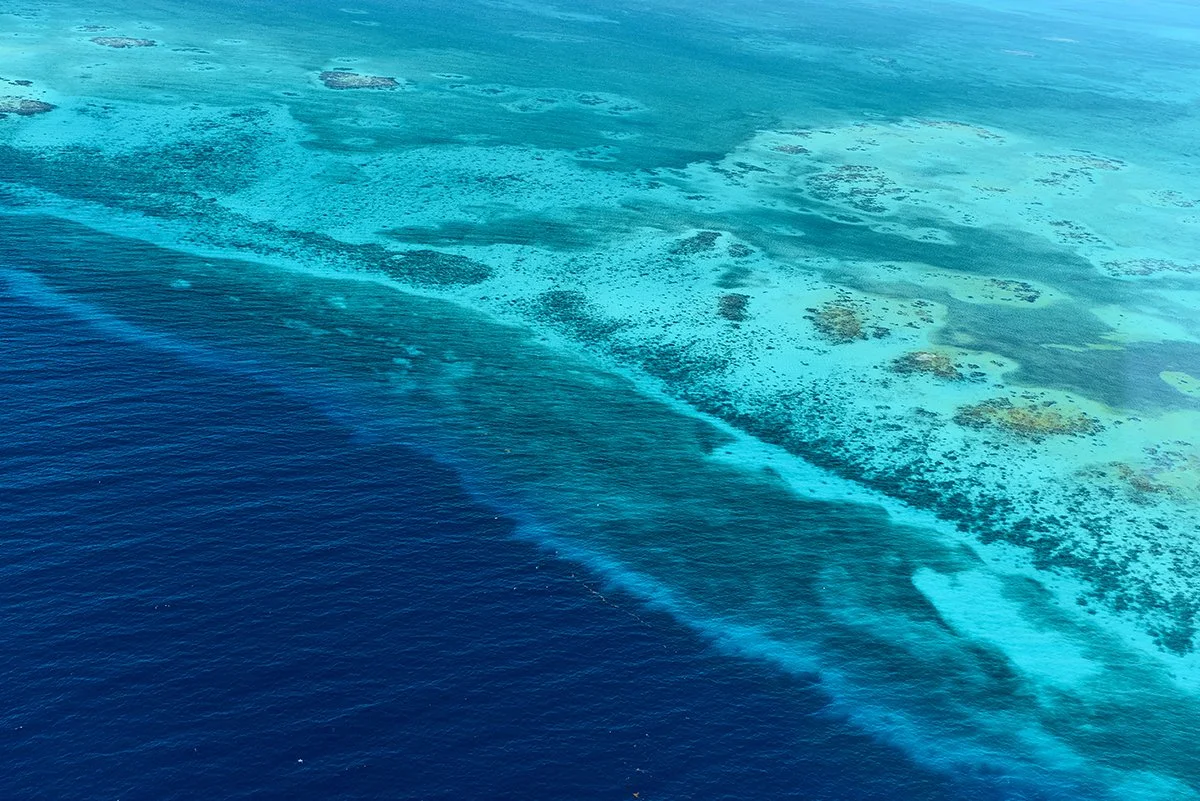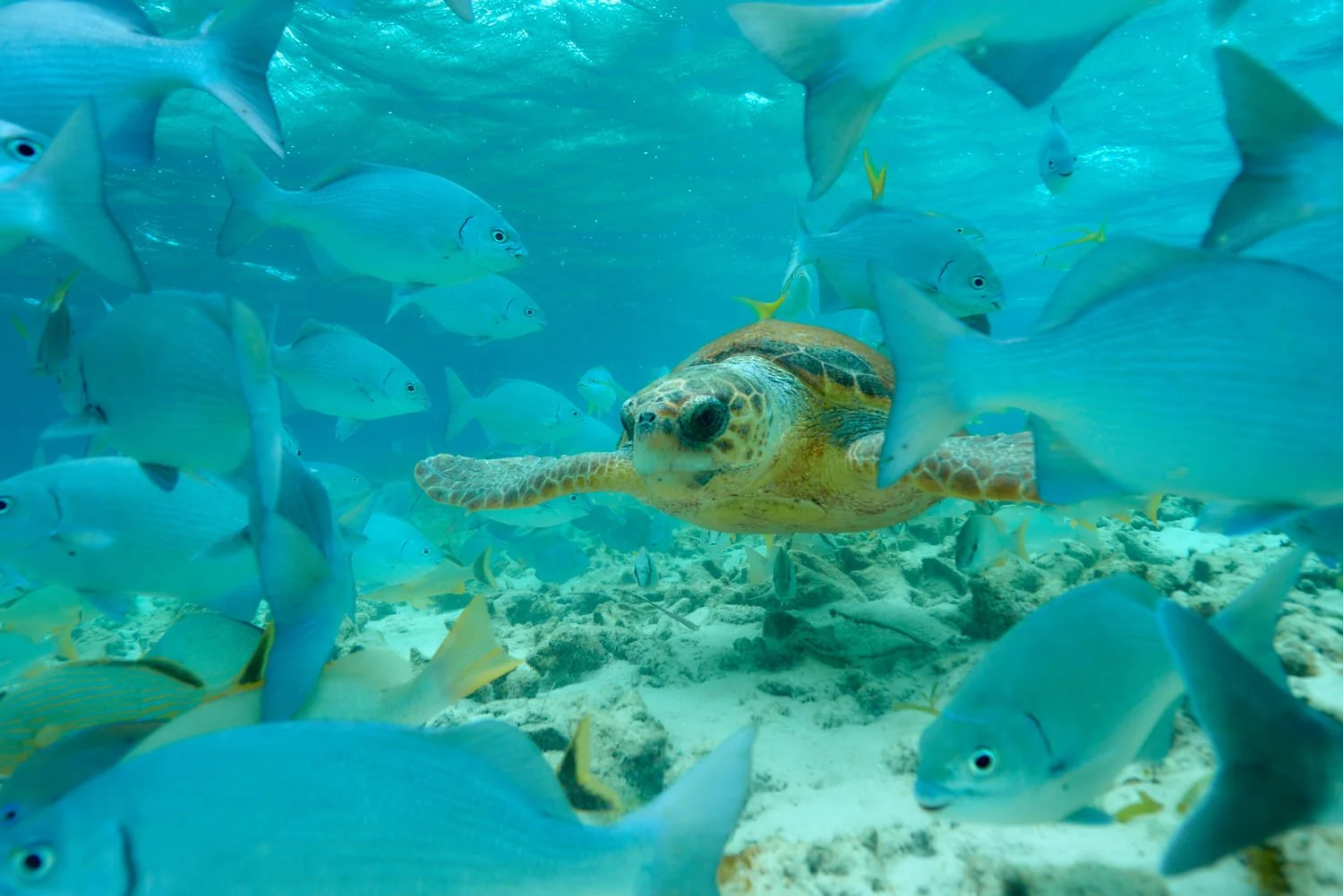Belize Barrier Reef: A Natural Wonder You Can’t Miss
Aerial View of The Belize Barrier Reef off Ambergris Caye
The Jewel of Belize
The Belize Barrier Reef stretches for more than 185 miles along the country’s coast and is part of the larger Mesoamerican Reef system. It’s not just big—it’s biologically spectacular and the largest living reef in the Western Hempisphere. With hundreds of cayes, atolls, and shallow lagoons, it supports a dazzling array of life, from colorful fish to gentle manatees. UNESCO named it a World Heritage Site because of its global importance, calling it one of the planet’s most remarkable ecosystems.
For travelers, this means something special, and you don’t have to be an expert diver to experience it. From many of Belize’s island, you can literally step off a boat just off the coast and within minutes be swimming above coral gardens alive with color and motion.
The Great Blue Hole: A Natural Wonder
The Great Blue Hole, by Air
No discussion of Belize’s reef is complete without the Great Blue Hole—a perfectly circular marine sinkhole over 1,000 feet across and 400 feet deep. Formed during the last Ice Age and later flooded by the sea, it’s an underwater time capsule filled with stalactites and unique limestone formations. Jacques Cousteau named it one of the top five dive sites in the world, and today it draws divers and adventure seekers from every corner of the globe.
Embark on a diving expedition to the Great Blue Hole and experience an underwater journey like no other .From above, it’s just as breathtaking. A helicopter flyover gives you that surreal aerial view of deep sapphire waters ringed by turquoise reef. Even if you’re not a diver, seeing the Blue Hole is an experience of a lifetime.
A Living Aquarium
The reef is alive with diversity: more than 500 species of fish, 100 types of coral, and countless marine creatures call it home. Spotted eagle rays glide gracefully, sea turtles munch on seagrass, and even the elusive West Indian manatee can be spotted. For bird lovers, the surrounding cayes are also nesting grounds for seabirds like frigatebirds and boobies.
Unlike some reef systems that require days of travel to reach, Belize’s reef lies just offshore, meaning anyone—from families with kids to first-time snorkelers—can experience its magic on a half-day tour.
Fish and Sea Turtles at Shark Ray Alley, Ambergris Caye
How to Experience the Belize Barrier Reef
There are so many ways to dive into this underwater world, whether you’re seeking adrenaline-pumping dives or laid-back snorkeling:
Snorkeling: Accessible for all ages, with popular sites like Hol Chan Marine Reserve and Shark Ray Alley.
Scuba Diving: World-class dive spots include the Blue Hole, Lighthouse Reef, and Turneffe Atoll.
Sailing & Catamaran Tours: Glide across turquoise seas, stopping at sandy cayes and reef patches.
Wildlife Encounters: Swim with nurse sharks, stingrays, and sea turtles in protected sanctuaries.
Kayaking & Paddleboarding: Explore calm lagoons and mangrove areas teeming with marine life.
Why the Reef Matters
Beyond its obvious beauty, the Belize Barrier Reef plays a vital role in protecting the country’s coastline from storms, supporting local fishing communities, and sustaining ecotourism. Every time you snorkel, dive, or sail here, you’re also contributing to the preservation of one of the world’s most important ecosystems. Belize has made significant efforts in reef conservation, including banning offshore drilling and promoting reef-safe practices.
Plan Your Belize Reef Adventure
A trip to Belize isn’t complete without time at the reef. Combine it with the country’s lush rainforests, ancient Maya ruins, and friendly island culture, and you’ve got the perfect mix of adventure and relaxation. Whether it’s your first time in the Caribbean or your tenth, the reef never ceases to amaze.




